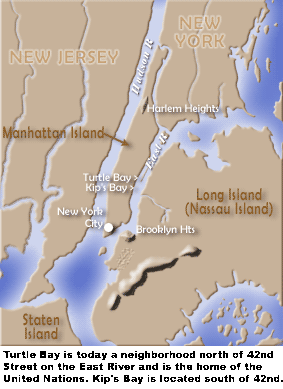In the days following the escape of American forces from Long Island (August 29-30), 1776, George Washington met with his staff and decided to deploy his forces in three locations:
 Early in the morning of September 15, British warships took positions on Kip’s Bay to provide protection for a flotilla of flat-bottomed boats that ferried 4,000 British soliers to Manhattan. American forces under Colonel William Douglas put up meager resistance before breaking and running. Washington observed the disarray from a hilltop vantage point, then rushed on horseback into the fray in an attempt to reform the Patriot lines. His cries of encouragement failed to have the desired effect and, increasingly angry, he swatted fleeing soldiers with the flat side of his sword. It was later noted that both privates and colonels were running from the battle and Washington treated both with “democratic indiscrimination.” The commander’s aides finally grabbed the reins of his horse and pulled him from the field in an effort to avoid his capture.
General Putnam gathered the American forces and marched them along the west side of the island toward Harlem Heights. The recently arrived British soldiers paralleled the American movement, but on the eastern side of Manhattan.
The Battle of Kip’s Bay placed New York City firmly in British hands, where it would remain for the course of the war. The city’s already large Loyalist population grew; other like-minded Americans fled there for protection.
American losses numbered 60 killed and wounded, and more than 300 captured. This dark picture was worsened by the fact that abandoned artillery and supplies fell into their opponents’ hands. By contrast, the British suffered only 12 casualties.
Early in the morning of September 15, British warships took positions on Kip’s Bay to provide protection for a flotilla of flat-bottomed boats that ferried 4,000 British soliers to Manhattan. American forces under Colonel William Douglas put up meager resistance before breaking and running. Washington observed the disarray from a hilltop vantage point, then rushed on horseback into the fray in an attempt to reform the Patriot lines. His cries of encouragement failed to have the desired effect and, increasingly angry, he swatted fleeing soldiers with the flat side of his sword. It was later noted that both privates and colonels were running from the battle and Washington treated both with “democratic indiscrimination.” The commander’s aides finally grabbed the reins of his horse and pulled him from the field in an effort to avoid his capture.
General Putnam gathered the American forces and marched them along the west side of the island toward Harlem Heights. The recently arrived British soldiers paralleled the American movement, but on the eastern side of Manhattan.
The Battle of Kip’s Bay placed New York City firmly in British hands, where it would remain for the course of the war. The city’s already large Loyalist population grew; other like-minded Americans fled there for protection.
American losses numbered 60 killed and wounded, and more than 300 captured. This dark picture was worsened by the fact that abandoned artillery and supplies fell into their opponents’ hands. By contrast, the British suffered only 12 casualties.